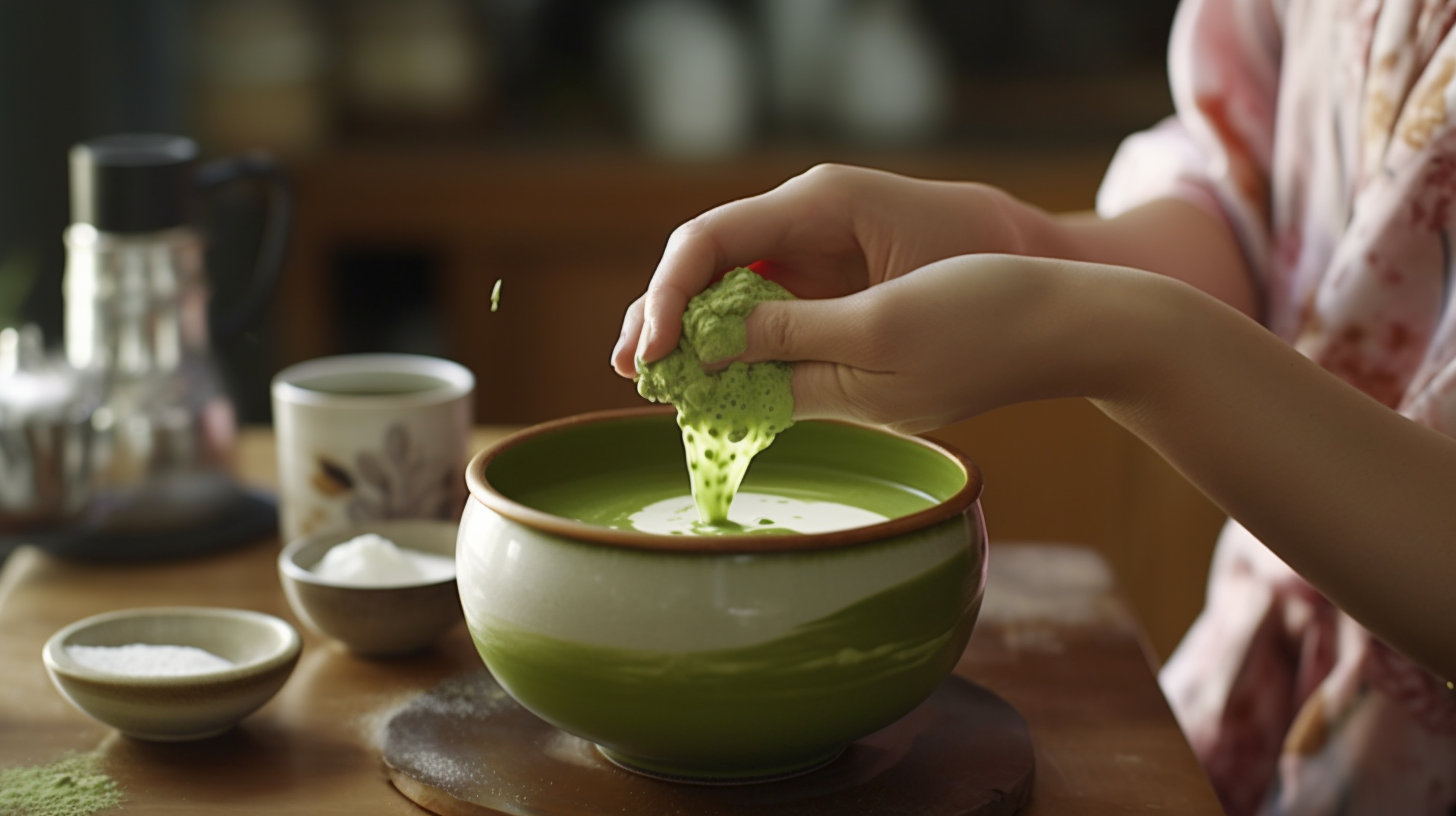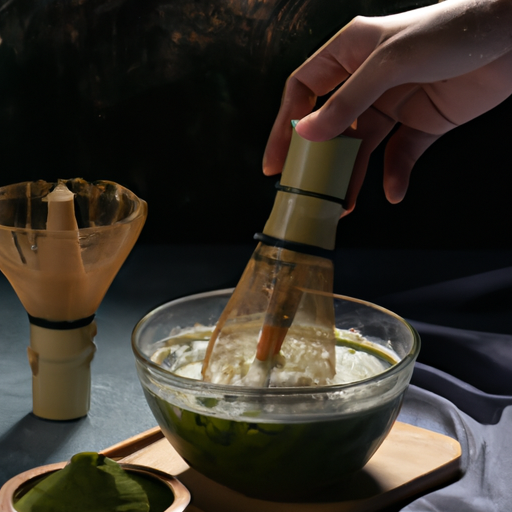Matcha Green Tea has seen a surge in popularity lately, and it’s not hard to see why given its health advantages and distinctive taste. However, have you ever paused to consider the actual hue of Matcha Green? Does it exhibit a vivid, lively green, or is it more of a subdued, softer green?
Well, I’m here to tell you that the color of Matcha Green is something truly remarkable and worthy of discussion. In fact, the color of Matcha Green is so striking that it’s almost impossible to ignore. It’s a color that can bring about feelings of happiness, energy, and rejuvenation. The shade of green is so intense that it’s almost as if you’re holding a piece of nature in your hands.
But why is the color of Matcha Green so important? And how does it impact the quality of the tea? Let’s dive into the world of Matcha Green and explore what makes this color so special.
Key Takeaways
- Matcha green tea has a bright and vibrant green color, symbolizing harmony, purity, and tranquility.
- The quality and flavor of matcha green tea are affected by factors such as the tea leaves’ quality, altitude and climate of the growing region, and processing methods used.
- Matcha can come in different shades, indicating how the leaves were harvested and processed, with vibrant green matcha having a strong flavor and aroma and brownish-green matcha having a weak flavor and aroma.
- The shade of the tea leaves can give valuable insight into matcha’s quality and flavor, and its color symbolism plays a significant role in Japanese culture.
What is Matcha Green Tea?
So, you’re probably wondering what matcha green tea is and why it’s so popular these days. Well, let me tell you, it’s a finely ground powder made from shade-grown green tea leaves that’s bursting with antioxidants and has a distinct earthy flavor.
Matcha is a staple in Japanese tea ceremonies and has been consumed for centuries for its health benefits. It is known for its high concentration of antioxidants, which can help reduce inflammation, boost your immune system, and prevent chronic diseases. Additionally, matcha contains caffeine and L-theanine, which work together to provide a calming effect while also increasing alertness and focus. This makes matcha a great alternative to coffee for those looking for a natural energy boost.
In addition to traditional tea ceremonies, matcha can be used in a variety of recipes, including smoothies, desserts, and even savory dishes. Its unique flavor and bright green color make it a popular ingredient in many modern dishes.
Now, let’s dive into the growing and harvesting process of matcha green tea.
The Growing and Harvesting Process
Growing matcha green tea requires a specific environment and careful attention during the cultivation process. The tea plants are shaded for several weeks before harvest to increase chlorophyll production and enhance the tea’s flavor.
After harvesting, the leaves are quickly steamed and dried before being ground into a fine powder.
Growing in the Shade
Interestingly, shade-grown matcha green tea leaves offer numerous benefits compared to those grown in direct sunlight. The process of growing matcha tea leaves in the shade involves covering the plants with bamboo shades for a few weeks before harvest. This technique increases the chlorophyll and amino acid content in the leaves, giving them a bright green color and a rich, creamy flavor.
Moreover, the increased chlorophyll content in the shade-grown leaves gives them a unique earthy taste and aroma that is characteristic of matcha green tea. Matcha color symbolism plays a significant role in Japanese culture, where it is associated with harmony, purity, and tranquility.
The bright green color of shade-grown matcha tea leaves is symbolic of spring and renewal, and it represents the balance between the mind, body, and spirit. The vivid green hue of high-quality matcha is a result of the shade-grown process, which enhances the natural sweetness and umami flavors of the leaves.
Overall, growing matcha tea leaves in the shade not only yields a unique color and flavor profile but also provides health benefits that make it a popular choice among tea enthusiasts. Moving on to the next section, let’s explore the harvesting and processing of matcha tea leaves.
Harvesting and Processing
The unique taste and aroma of shade-grown matcha tea leaves are a result of the careful harvesting and processing techniques used by skilled tea producers. Hand picking is a crucial step in the process, as it ensures that only the youngest and most tender leaves are selected for grinding.
The leaves are picked by hand and immediately taken to a processing facility where they are sorted, steamed, and dried. After the drying process, the leaves are ground into a fine powder using traditional stone grinding methods. This slow and delicate process ensures that the matcha powder is finely ground and of the highest quality.
The resulting powder is then carefully packaged and sent out to consumers all over the world. The importance of chlorophyll in matcha tea will be discussed in the subsequent section.
The Importance of Chlorophyll
Chlorophyll, like the pigment that gives matcha its green color, is like the lifeblood of plants. It is responsible for photosynthesis, a process that converts sunlight into energy for plants.
Chlorophyll is also known for its numerous health benefits, such as improving digestion, detoxifying the body, and boosting the immune system. It is present in many green vegetables, but matcha green tea is one of the most chlorophyll-rich foods around.
The benefits of chlorophyll are numerous, and incorporating it into your diet can have a positive impact on your health. Chlorophyll has been shown to reduce inflammation, promote healthy skin, and even protect against cancer. It is also a powerful antioxidant, which means it can help fight off free radicals and prevent cellular damage.
Matcha green tea, which is made from ground-up green tea leaves, is an excellent source of chlorophyll and is a great way to incorporate this powerful nutrient into your daily routine.
Factors that affect matcha green’s color include the quality of the tea leaves, the altitude and climate of the growing region, and the processing methods used. These factors can all have an impact on the shade of green that the matcha tea produces. However, regardless of the shade of green, matcha tea will always have the same great taste and health benefits that come from the high concentration of chlorophyll and other nutrients.
Factors That Affect Matcha Green’s Color
Now that we understand the importance of chlorophyll in matcha green, let’s dive into the factors that affect its appearance and color.
There are several factors that contribute to matcha’s unique hue, such as its growing conditions, processing methods, and quality of tea leaves.
The first factor that affects matcha’s color is the growing conditions. Matcha is grown in shaded areas, which helps to increase the chlorophyll and amino acid content in the tea leaves. The amount of shade and the duration of shading can vary, resulting in different shades of green.
The second factor is the processing method. Matcha leaves are picked and steamed before being ground into a fine powder. The way in which the leaves are steamed and dried can impact the final color of the matcha.
Lastly, the quality of the tea leaves used to make matcha can affect its color. Higher quality tea leaves are typically younger and harvested earlier in the season, resulting in a brighter, more vibrant green color.
As you can see, there are several factors that contribute to matcha’s unique appearance and color.
Next, we will explore the different shades of matcha and what they signify. It’s important to understand these differences in order to choose the right matcha for your needs.
The Different Shades of Matcha
Let’s explore the varying hues of matcha and what they can reveal about the tea’s quality and flavor. Matcha can come in different shades, and these hues indicate how the leaves were harvested and processed. Here are some of the hues that you might come across when you’re shopping for matcha:
-
Vibrant green: This shade of matcha is a sign that the tea leaves were harvested at the right time. The leaves were picked when they were young and tender, and they were processed carefully to retain their color and nutrients. Vibrant green matcha has a strong flavor and aroma, and it’s perfect for making traditional tea bowls.
-
Yellowish-green: This hue of matcha is a sign that the tea leaves were harvested when they were a bit older. The leaves might have been exposed to more sunlight, which can affect their color. Yellowish-green matcha has a milder flavor and aroma than vibrant green matcha, but it still has plenty of health benefits.
-
Brownish-green: This shade of matcha is a sign that the tea leaves were harvested when they were too old. The leaves might have been exposed to too much sunlight or processed improperly. Brownish-green matcha has a weak flavor and aroma, and it’s best avoided.
These different hues of matcha can affect how the tea tastes and smells, so it’s important to choose the right one for your brewing techniques. In the next section, we’ll explore the role of color in matcha’s quality and how you can use it to your advantage.
The Role of Color in Matcha’s Quality
When you’re selecting your matcha, the shade of the tea leaves can give you valuable insight into its quality and flavor. Matcha comes in a range of colors, from a deep, vibrant green to a lighter, more muted shade.
The color spectrum of matcha is determined by a variety of factors, including the age of the tea leaves, the region in which they were grown, and the processing methods used. The relationship between color and flavor in matcha is closely linked.
Generally speaking, matcha that is a brighter, more vivid green will have a more intense and complex flavor profile than matcha that is a lighter shade. This is because the deeper green color indicates that the tea leaves were grown in nutrient-rich soil and were harvested at the optimal time.
Matcha that is a pale green or even yellowish in color may taste less flavorful or even bland. When choosing the best matcha, it’s important to pay attention to the color of the tea leaves.
Look for matcha that is a vibrant, rich green color, as this is a sign that the tea leaves were grown in optimal conditions and harvested at the right time. In the next section, we’ll explore other factors to consider when selecting the best matcha for your needs.
How to Choose the Best Matcha
To truly savor the rich and complex flavors of a high-quality matcha, it’s crucial to carefully consider the source of the tea, the growing and harvesting methods, and the processing techniques.
Matcha grades play a significant role in determining the quality and flavor profile of the tea. The highest grade, ceremonial grade, is made from the youngest leaves, which are hand-picked, steamed, dried, and stone-ground into a fine powder. This results in a vibrant green color, a delicate aroma, and a smooth, sweet taste with no bitterness.
On the other hand, culinary grade matcha is usually made from older leaves that are machine-harvested and processed differently, resulting in a less vibrant green color, a stronger bitter taste, and a less delicate aroma. Despite this, culinary grade matcha is still a good choice for cooking and baking, as its flavor profile can blend well with other ingredients to create delicious treats.
When choosing the best matcha, it’s important to consider the grade and flavor profile of the tea. While ceremonial grade matcha is ideal for drinking on its own, culinary grade matcha can still be a great choice for cooking and baking.
In the next section, we’ll explore some common uses of matcha in culinary creations and beverages.
Common Uses of Matcha
You’ll be delighted to know that matcha is incredibly versatile and can be used in a wide range of culinary creations and beverages. The powder can be incorporated into smoothies, lattes, cakes, and even savory dishes like pasta sauces and marinades. Some popular matcha recipes include matcha ice cream, matcha latte, matcha pancakes, and matcha cheesecake.
Here are four of my favorite matcha recipes that not only taste delicious but also offer the many health benefits of matcha.
-
Matcha Latte: This creamy and frothy beverage is perfect for a morning pick-me-up or an afternoon treat. Simply whisk together matcha powder, hot water, and your choice of milk (dairy or non-dairy) and sweetener (honey, agave, or maple syrup).
-
Matcha Smoothie: This refreshing drink is packed with antioxidants, vitamins, and minerals. Blend together matcha powder, frozen banana, almond milk, spinach, and vanilla extract for a nutritious and delicious smoothie.
-
Matcha Pancakes: These fluffy pancakes are a fun and unique twist on a classic breakfast dish. Mix together matcha powder, flour, sugar, baking powder, and milk to create the batter. Serve with your favorite toppings like fresh fruit, whipped cream, or maple syrup.
-
Matcha Ice Cream: This creamy and indulgent treat is perfect for hot summer days. Simply mix together matcha powder, heavy cream, condensed milk, and vanilla extract. Freeze in a container for several hours and enjoy!
Incorporating matcha into your diet is not only delicious but also offers many health benefits. Matcha is packed with antioxidants, boosts metabolism, and enhances mood and concentration. As matcha continues to gain popularity, I can’t wait to see what innovative and delicious recipes will be created next.
Now, let’s take a look at the future of matcha and how this versatile ingredient will continue to impact the culinary world.
The Future of Matcha
As matcha gains popularity, I can’t help but wonder how chefs and home cooks alike will continue to innovate and find exciting ways to incorporate this versatile ingredient into their culinary creations. Matcha has already become a staple in many kitchens, from blended drinks to baked goods and savory dishes. But what’s next? Will we see matcha-infused oils, marinades, or even soups? The possibilities are endless, and I can’t wait to see what the future holds for this beloved ingredient.
One trend that I hope to see more of in the matcha world is sustainability initiatives. As the demand for matcha continues to rise, it’s important that we think about the impact that our consumption has on the environment. From sourcing practices to packaging and waste reduction, there are many ways that chefs and home cooks can make a difference.
I’m excited to see how the industry will respond to this challenge and find creative solutions to make matcha production more sustainable. At the end of the day, what I love most about matcha is its versatility and adaptability. Whether you’re a professional chef or a home cook, there’s always room to experiment and find new ways to use this vibrant green powder.
As we look ahead to the future of matcha, I’m confident that we’ll continue to see exciting innovations and sustainable practices that will make it an even more beloved ingredient for years to come.
Frequently Asked Questions
How does the taste of matcha green tea differ from other types of tea?
When it comes to the taste of matcha green tea, it’s important to understand its unique flavor profile.
Matcha has a complex taste that’s both vegetal and sweet, with a slight bitterness that balances out the sweetness. Compared to other types of tea, matcha is much richer and more full-bodied, with a creaminess that’s often described as similar to milk.
Additionally, matcha has a distinct umami flavor that sets it apart from other teas. While other teas may be more delicate or floral, matcha’s bold and robust flavor makes it a favorite among tea enthusiasts.
Overall, the taste comparisons between matcha and other teas showcase the unique and delicious qualities of this traditional Japanese beverage.
Can matcha green tea be used for cooking or baking?
Let’s be honest, the only thing better than a cup of matcha green tea is a dessert made with matcha green tea. And yes, you’ve heard me right, matcha isn’t just for drinking.
Matcha recipes and matcha desserts are all the rage these days, and for good reason. Matcha’s earthy, slightly bitter flavor pairs perfectly with sweet treats like cakes, cookies, and ice cream. You can use matcha powder to add a vibrant green hue and a unique flavor to your favorite baked goods.
So next time you’re in the mood for something sweet, try incorporating matcha into your recipe and see what all the fuss is about. Trust me, your taste buds will thank you.
What are the health benefits of drinking matcha green tea?
Drinking matcha green tea has numerous health benefits that make it a popular choice for health enthusiasts. As someone who regularly drinks matcha, I’ve experienced an improvement in my mental clarity and focus.
This is because matcha contains caffeine and L-theanine, which work together to provide a sustained boost of energy without the jitters that come with coffee. Additionally, matcha has been shown to increase metabolism and aid in weight loss.
It’s also packed with antioxidants, which can help reduce the risk of chronic diseases such as cancer and heart disease.
Overall, drinking matcha green tea is a great way to boost your health and well-being.
How should matcha green tea be stored to maintain its quality?
Proper storage of matcha green tea is crucial to maintain its quality and preserve its health benefits. As a tea enthusiast, I’ve learned that preservation techniques are essential to keep the tea fresh and delicious.
The best way to store matcha green tea is to keep it in an airtight container away from light, heat, and moisture. These factors can affect the tea’s quality, color, and taste. It’s also crucial to avoid exposure to strong odors as matcha can quickly absorb them.
To ensure the tea’s longevity, I always store it in a cool, dark place, such as a pantry or cupboard. By following these proper storage techniques, you can guarantee that your matcha green tea will retain its flavor and nutritional value for an extended period.
Are there any potential side effects of consuming matcha green tea?
Consuming matcha green tea may lead to potential side effects, especially for those sensitive to caffeine. Some people may experience digestive issues, such as nausea, stomach cramps, or diarrhea after consuming matcha green tea.
Additionally, matcha green tea contains higher levels of caffeine compared to regular green tea. This can cause caffeine sensitivity reactions, such as jitters, rapid heartbeat, or insomnia. It’s important to monitor your caffeine intake and consult with a healthcare professional if you experience any adverse effects.
Conclusion
In conclusion, as a matcha enthusiast, I can confidently say that the color of matcha green is a crucial factor in determining its quality. The vibrant green hue is an indication of the tea leaves’ freshness, growing conditions, and harvesting process. It also signifies the high amounts of chlorophyll present in the tea, which is a vital nutrient that provides several health benefits.
When I see a bright green matcha, it evokes a sense of excitement and satisfaction, knowing that I’m about to enjoy a cup of high-quality tea. The color also adds to the overall experience, making it more visually appealing and enjoyable.
Therefore, when selecting matcha, it’s essential to pay attention to its color to ensure that you’re getting the best possible quality. As the popularity of matcha continues to grow, it’s exciting to see how this beloved tea will evolve and what new uses and benefits it’ll offer.










